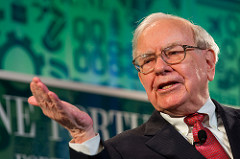Risk
Courtesy of Michael Batnick
 In Berkshire’s 2017 annual letter, Buffett reviews details of “the bet” made ten years earlier with Protégé Partners, a fund of funds. The bet, which was made in the beginning of 2008, was very simple: could Protégé pick five fund of funds to beat the S&P 500 over the next decade?
In Berkshire’s 2017 annual letter, Buffett reviews details of “the bet” made ten years earlier with Protégé Partners, a fund of funds. The bet, which was made in the beginning of 2008, was very simple: could Protégé pick five fund of funds to beat the S&P 500 over the next decade?
At the time the bet was made, both Berkshire and Protégé put $318,250 into zero-coupon U.S. Treasury bonds, which would deliver $1,000,000 in ten years. By late 2012 however, these bonds had a paltry annual yield-to-maturity of 0.88%. So Berkshire and Protégé decided to swap it for Berkshire Hathaway stock. This proved to be a wise decision. Instead of the $1 million that the bet would deliver to Girls Inc. of Omaha, they instead received $2.22 million.
Buffett used this as an opportunity to talk about risk:
Investing is an activity in which consumption today is foregone in an attempt to allow greater consumption at a later date. “Risk” is the possibility that this objective won’t be attained.
By that standard, purportedly “risk-free” long-term bonds in 2012 were a far riskier investment than a longterm investment in common stocks. At that time, even a 1% annual rate of inflation between 2012 and 2017 would have decreased the purchasing-power of the government bond that Protégé and I sold.
I want to quickly acknowledge that in any upcoming day, week or even year, stocks will be riskier – far riskier – than short-term U.S. bonds. As an investor’s investment horizon lengthens, however, a diversified portfolio of U.S. equities becomes progressively less risky than bonds, assuming that the stocks are purchased at a sensible multiple of earnings relative to then-prevailing interest rates.
It is a terrible mistake for investors with long-term horizons – among them, pension funds, college endowments and savings-minded individuals – to measure their investment “risk” by their portfolio’s ratio of bonds to stocks. Often, high-grade bonds in an investment portfolio increase its risk.
People invest for a purpose, but absent a plan, it’s easy to lose sight of why we’re doing this in the first place. While bonds fluctuate less than stocks over the short run, they’ll deliver less in the long run, so it’s critically important for investors to balance their ability to handle volatility today in order to accomplish their goals tomorrow.
Source:
Picture of Warren Buffet: flickr.
Picture of at-risk bird: pixabay.



